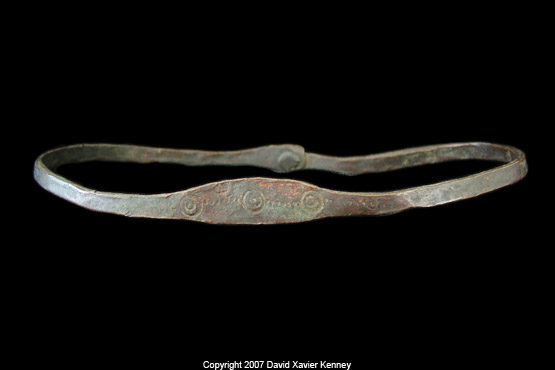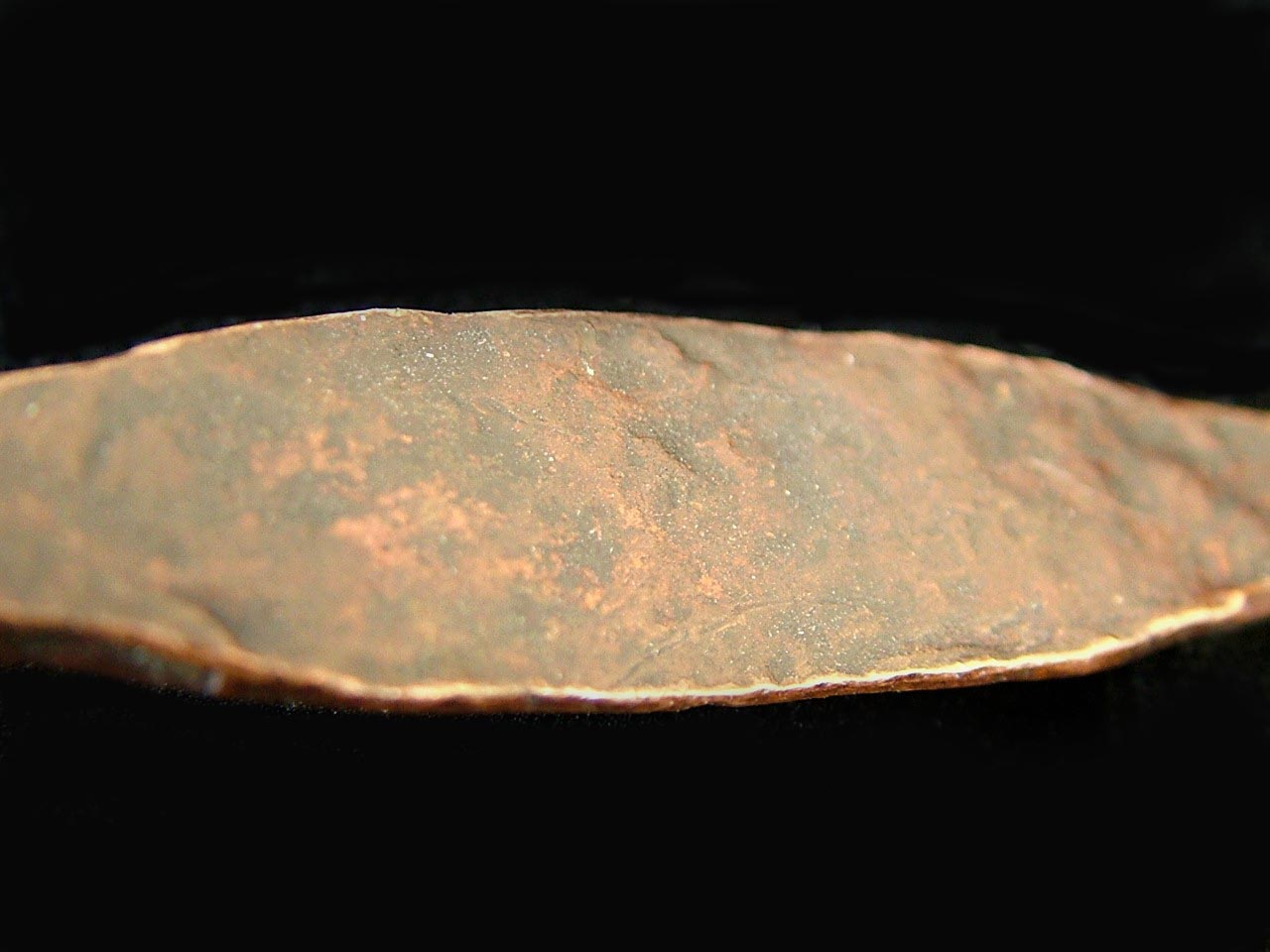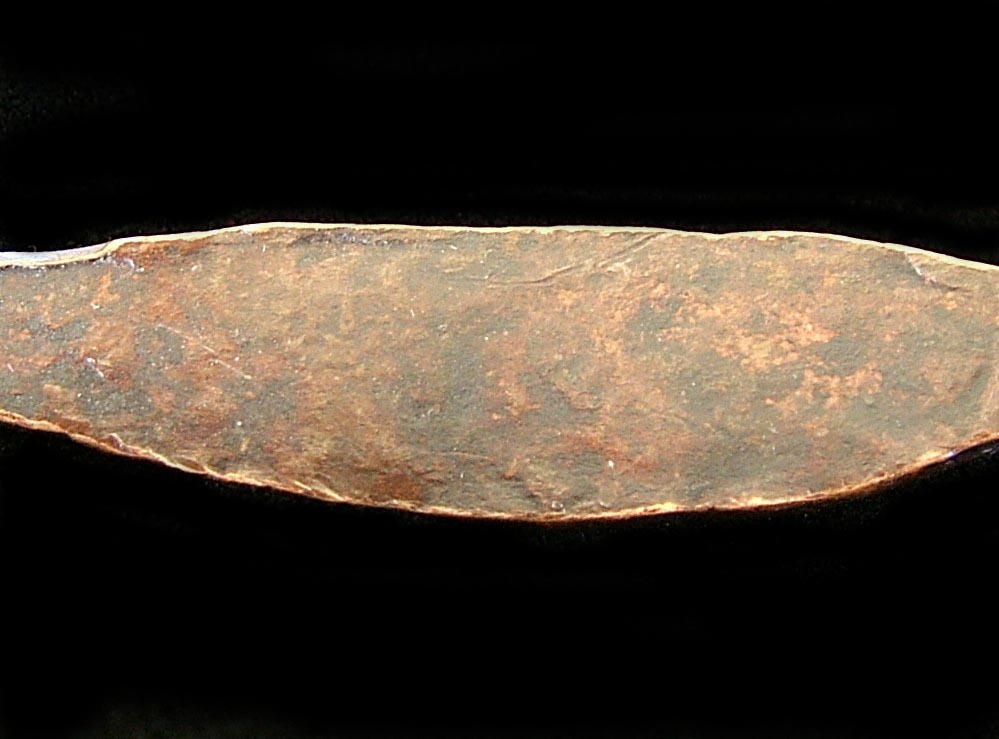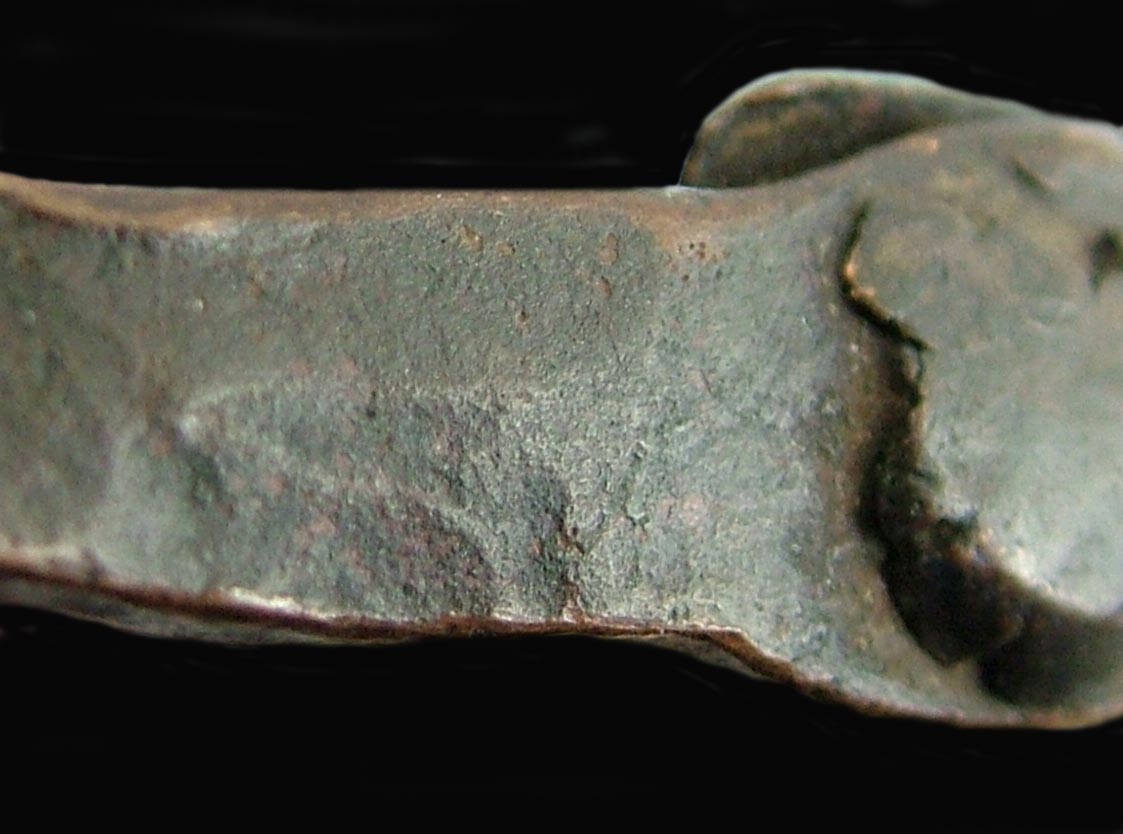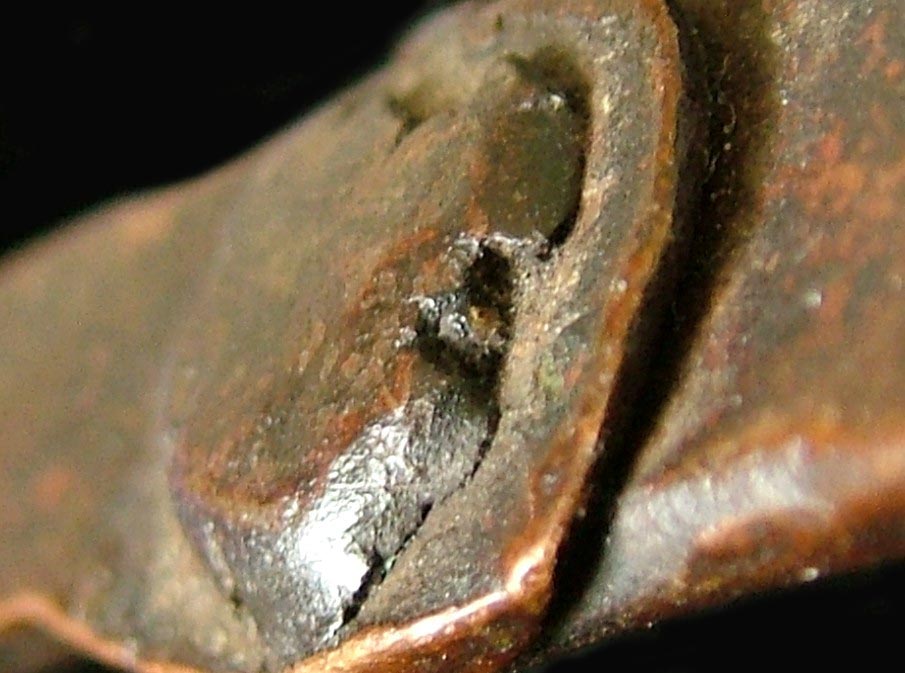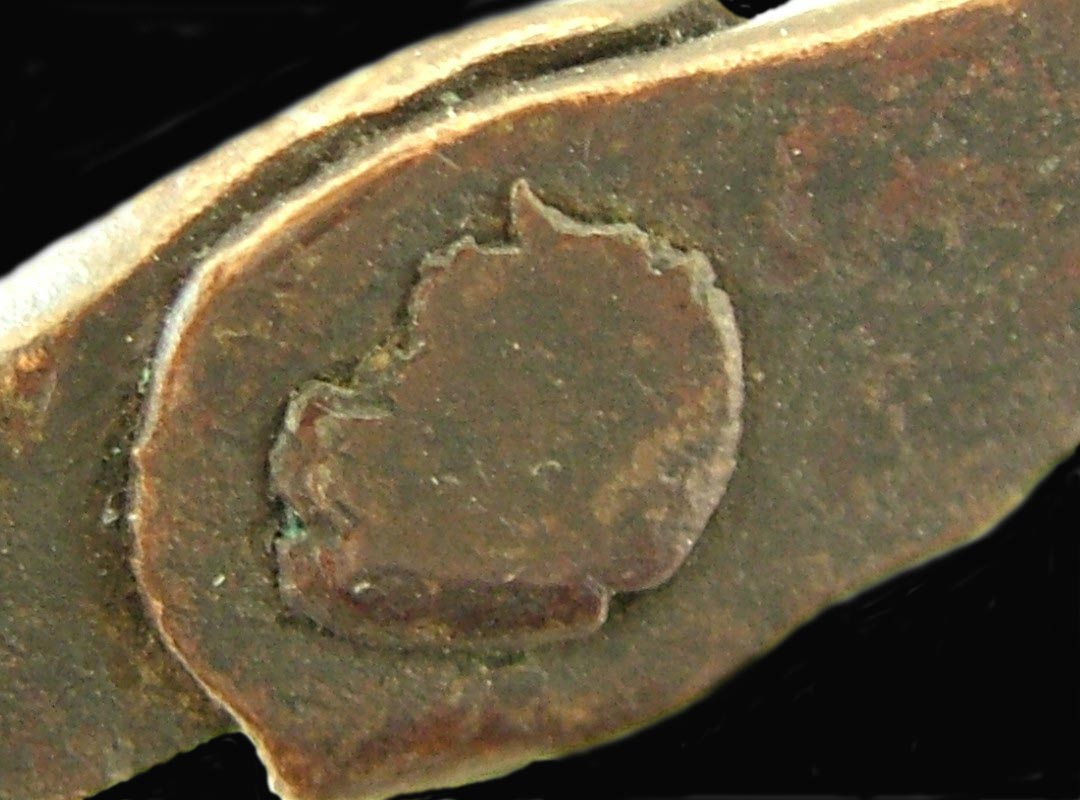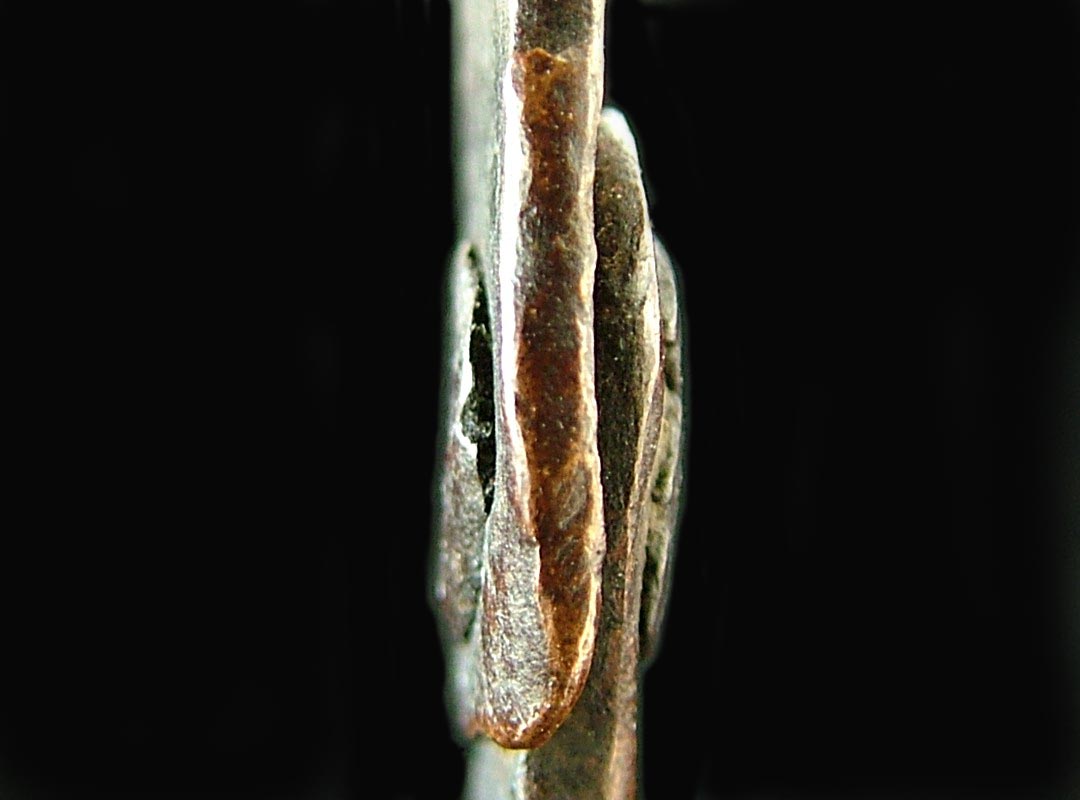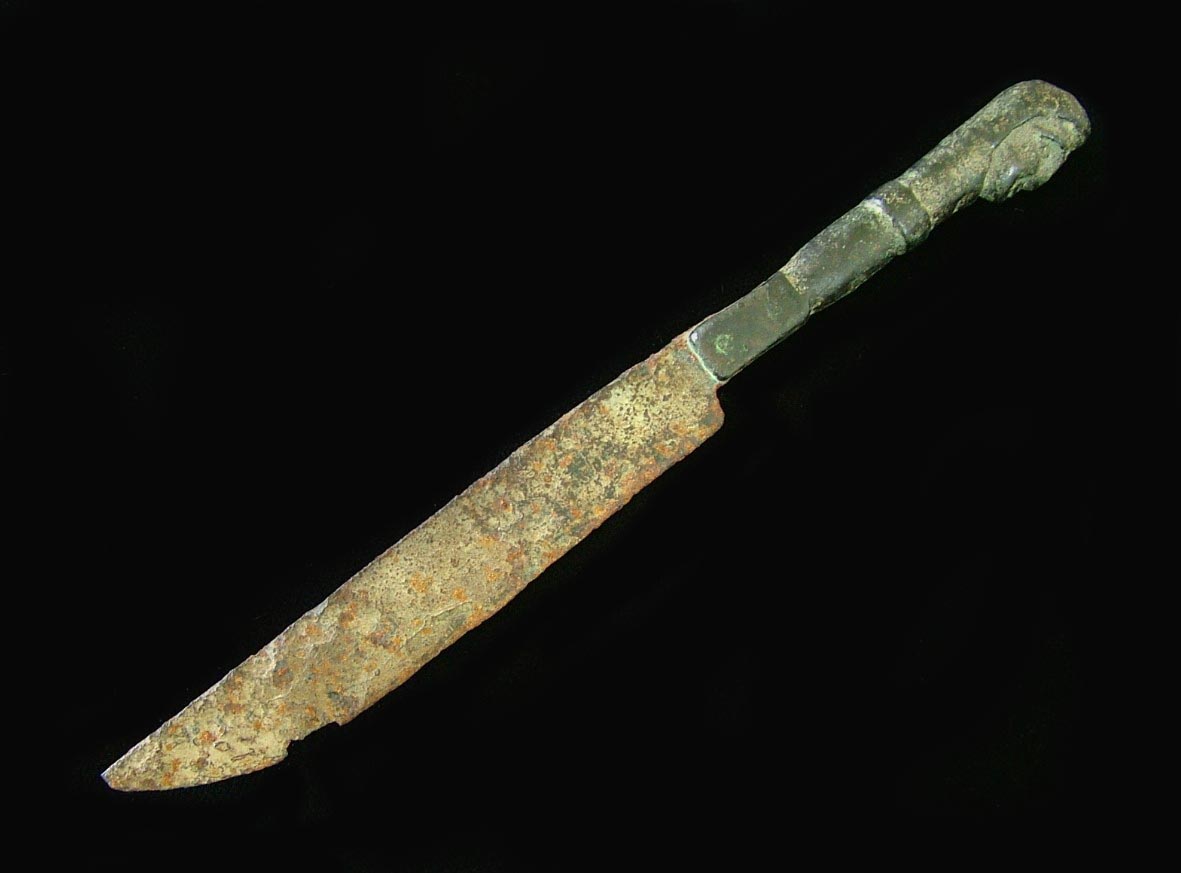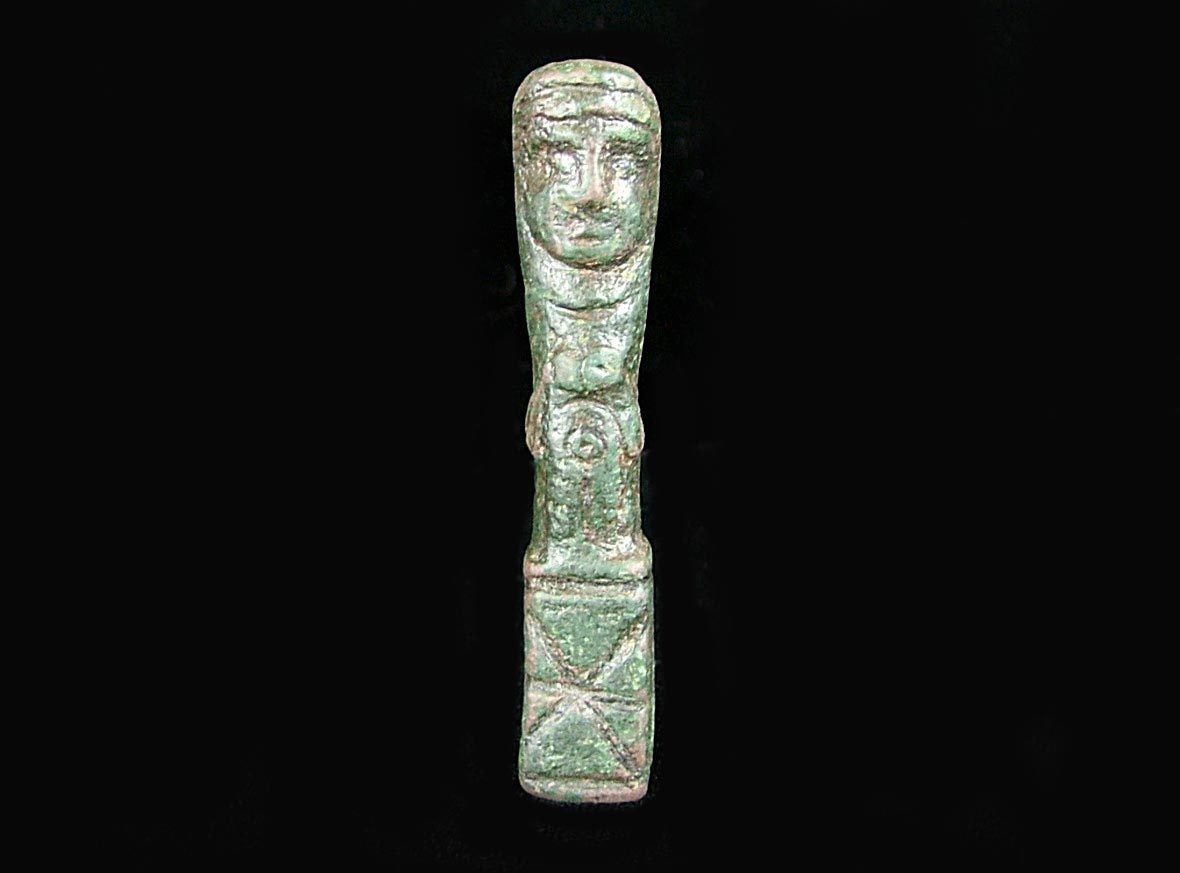 |
|---|
Merlin Necklace |
|||||||||||||||||||
| Necklace Description and Front |
|||||||||||||||||||
| This Briton Druid Copper Necklace Device was purchased in 2002 from an English collector/dealer. It is from the 1st to 4th C. AD. It is an open end necklace, at some point the two ends had been permanently attached with two rivets (a thin type of torc), it has some lead overlay and paint. There was no other provenance but the smooth patina is typical of what is seen on artifacts originating from older collections Some of the symbolism reflected in the miniature art and its balanced shape show that this necklace was also used as a scientific device, specifically a seismograph. When the necklace/device is placed on a smooth surface and one end is tipped then let go, the following sounds are consistently created in compliance with its motion: The device begins with an abrupt vibrating sound and rocking; it will then briefly change into a slower sound and rocking; which will suddenly turn into a steady rocking that will create a clopping sound (similar to the trotting of an animal with hooves). The sound will then slowly fade, and will change to a steady tapping that speeds up until it begins to vibrate with a sound similar to that made by a marble hitting a hard surface; it will then abruptly stop. There are three major sounds and motions and two minor sounds and motions that are made always in the same sequence. The evolution of this will usually last for 20 seconds, but it can be as much as 25 seconds, depending on the amount of force applied. The device can be set into motion with any type of a sudden movement of a surface. Therefore even a slight tremor from the earth would set this device into motion. Some of the art on the rivets in back suggest that this device may have been thought to also be associated with great waves and a volcanic island that may have been known in legends but considered other worldly. If so, then other art shows that the island referred to was most likely Iceland. Other information is that as of right now it appears that this artifact may have originated from Wales. The art and inscriptions show an immense amount of information on the ancient Arthurian traditions of the Welsh Britons, the Britons from the South Western English and the Irish Celts. There is every indicator that this type of necklace was a device that had been used to alter a Druid's voice. This would have been done with a wooden, bone, or metal rectangle or disc placed in front of the Druid's adam's apple and a copper (such as this example) or other pliable necklace securing it. This can be seen on the Medieval knife and the more ancient scroll device (it is a tool to handle the parchment without touching it with the hand) that are listed with this artifact show an ancient Druidic god wearing this type of device The front shows engraved work, there are three circle symbols on the front, but the band also has two lightly engraved circles. These are all connected by dotted work. Over the larger center circle in Pictures 5 thru 7 there is a leaping boar. At another angle the boar turns into a face in front of another face of a creature. What was the boar's tusk may now be a boat, inside there is a small white disc with a dot, it my represent an eye. Copyright 2008 David Xavier Kenney Revised Dec 08 |
|||||||||||||||||||
Necklace Front Back
|
|||||||||||||||||||
| The back shows various figures that seem to represent a Celtic mythological story. The top has one speck of silver, this can be best seen in Picture 6. It has an "X" inside a square with a handle, it may represent one of the celestial Dippers. Although it is very light Pictures 10 thru 17 show the top of an upright sword with a cruciform hilt and ring pommel, it is in a stone, but at another angle it shows that it is also in a caldron, there are various figures around this. Picture 16 shows a large head over the sword, over this is a figure with a sword or dagger that is sticking it into the nose of another figure. |
|||||||||||||||||||
Necklace Front Back Upside Down
|
|||||||||||||||||||
| The front of the back upside down shows various figures. Of interest is the upside down sword hilt of the sword in the stone, it is in the area to the right. This appears as nude body, on each side there is a figure as if working the arms of the nude figure, it is as if they are creating the cruciform hilt with it's arms. This should be connected to the anthropomorphic hilts of the earlier Celtic swords. Under this there is a creature with a man's head. |
|||||||||||||||||||
Necklace Back Band and Outer Rivet
|
|||||||||||||||||||
| The back of the necklace's band shows various figures. The outer rivet shows that it is an island, it is also a bald figure that appears to be a giant. There is a flat topped area that has several enclosures, these all have figures and scenes.In some of the photos there is a figure in a flat topped hat, he can be seen holding a vertical knife or at other angles a vertical sword, it as if he is killing the giant. In other pictures he is shown as if in a sled that is pulled by a man that may also be a creature. |
|||||||||||||||||||
Necklace Outer Rivet and Back Band
|
|||||||||||||||||||
| The pictures with this group show the back rivet on it's side. The focus of this group of pictures is with Pictures 3 thru 16 as it shows a scene of a Druid and, or a Druidess. These are the only images known of an ancient British Druid. There is one speck of gold, in some of the pictures it shows that the speck of gold is a flaming spear head of a figure upside down. The Druidic figure is in white, the brighter images of this are due to light reflection. With this Pictures 6 thru 8 show a large bear behind the Druidic figure. Pictures 11 thru 13 show the area of the large bear now as the head of a large cat, perhaps a panther. Pictures 27 thru 32 show that the flat topped area could be a the stump of a large tree (perhaps a sacred tree that had been cut down), there are figures in a scene painted on this, due to this it may also be a round table. The last pictures are of the necklace's band on it's the other side of the rivet. Pictures 27 thru 39 show a Briton Celt in a conical hat, he may be holding a shield. |
|||||||||||||||||||
|
| |
Necklace Inside Rivet |
This group of pictures is of the inside of the necklace band. It should represent another island, but as where the outer rivet may have been an actual known island this island may have been legendary, due to it's iconography it most likely was thought of as other worldly. Note that with the first few pictures the rivet appears to have the outline of an apple. Picture 4 hints of some kind of rodent. Pictures 5 thru 7 hint of a hare. Pictures 12 thru 15 show a boat with figures in it, pictures 16 thru 20 show a whale that is also a boat with figures in it, one figure holds a spear or a harpoon.
|
| |
Necklace Rivets |
This group of pictures shows the rivets when seen together, there is a curved knife in it's sheath with the rivets as figures on either side. This most likely represents a legend of an ancient sacred fishing or hunting knife, many ancient artifacts from all cultures show the theme of a sacred knife or dagger. The last pictures show the rivets from another view, it may or may not have someting to woth a great wave and an island.
|
| Migration Period or Early Medieval Knife This is a bronze and iron Migration Period or Early Medieval Knife, it is of an Eastern European god or Drudic folk figure that may be associated with speech or song. Notice the banded area on the neck. |
|
|
Late Roman or Sub-Roman Scroll Device |
My speculation is that this is a bronze device that was used for handing scrolls, it had once been gold gilded. It may be from the British Isles, it is definitely from Western Europe. It was thought to be Medieval, but inscriptions on the opening show that it may be from the Late Roman or sub-Roman (or Migration) Period. It is of a Druidic figure associated with speech and writing. Notice the neck area. . . Copyright 2008 David Xavier Kenney Revised 2009 | ||||||

